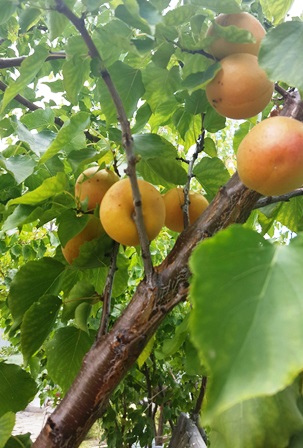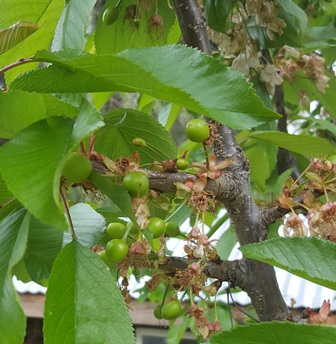How to Grow a Fruit Tree from a Pit
Nothing beats a breakfast of summer fruit picked fresh from a patio or backyard tree. I’m referring to fruit trees such as apricots, peaches, and nectarines. Cherries and plums are also among my favorites. The fruit from these trees is often referred to as stone fruit because of the hard pits (holding the seed) around which the fruit forms.

By mid-May, ripe apricots hanging on the trees in my backyard don’t last long–they’re eaten fresh, made into jams, and dried
Apricots in the Bay Area ripen in mid-May and peaches often ripen a bit later during the three months of summer (depending on the cultivar). If you love eating the fruit, don’t toss the pits. Consider that an apricot or peach grafted onto rootstock might cost upwards of $20 during bare-root season but $35 to $50 if sold in a pot. Growing from seed costs nothing.
Planting the seed extracted from the pit of your favorite apricot or peach variety can generate a tree with a very good chance of carrying the parent trees’ traits and producing fruit within three to five years. In fact, I’ve found that pits of my apricot, cherry, wild plum, peach, and nectarines that are left on the ground or discarded by the squirrels who’ve eaten the fruit will often sprout on their own.
Use this ten-step method to grow a peach or apricot tree from seed.
1. Choose a pit from a locally grown ripe fruit that tastes juicy and delicious.
2. Dry the seed on a paper towel in your kitchen window for several days.
3. Carefully crack open the hard shell of the pit to reveal the seed inside (it will resemble an almond).
4. Put the seed (or several seeds) in a sealed container in your refrigerator and let it chill for up to three months. The cool temperature exposure helps the seed get ready to sprout.
5. Time your removal of the seed from the refrigerator to a month before the last frost date in your area.
6. Cover the seed in water overnight and in the morning plant it a clear glass jar of potting soil (no lid on the jar).
7. Return the jar to the refrigerator and keep the seed moist until it has sprouted (about one month).
8. When the outside weather conditions are right (no more frost and the soil begins to warm), plant the seedling in your garden in fertile, well-drained soil.
9. Dig a basin around the planting hole for watering.
10. Mulch to keep down weeds and ensure the roots stay cool. In three years, watch for blossoms in the spring with fruit to follow.

Cherry pits are much smaller than other stone fruit; pits of sour cherries (and also wild plums) may self-seed but sweet cherries less so. Cherries must have a period of cold to germinate
* * *
If you enjoy farmette topics like gardening heirloom vegetables, herbs, and fruits as well as keeping chickens and bees, check out my Henny Penny Farmette series of cozy mysteries from Kensington Publishing–A Beeline to Murder, The Murder of a Queen Bee, and A Hive of Homicides.
You’ll find in the Henny Penny Farmette series
-
Delicious recipes
-
Farm quips and quotes
-
Tips for gardening and keeping chickens and bees
-
An exciting whodunnit mystery
Also, check out MY POCKET MEDITATIONS, my newest forthcoming nonfiction title from Adams Media/Simon & Schuster, at http://tinyurl.com/l6lzorq
![My Pocket Meditations: Anytime Exercises for Peace, Clarity, and Focus by [Lester, Meera]](https://images-na.ssl-images-amazon.com/images/I/51GH%2BXEPc6L.jpg)
What’s Not to Love about Edible Figs?
Many backyard gardeners start checking their fig trees this time of year for ripe fruit. Most figs grown for their fruit bear two crops a year (spring and fall). When figs are ripe, the globular fruit becomes soft and hangs downward from the branch. This fruit will not ripen on the windowsill or in a paper bag, so picking fruit while it is still firm is not advised.
I grow White Genoa, Adriatic, and Brown Turkey figs on my farmette. One of my nearest neighbors grows the Mission fig, which is a very large tree taking up most of his backyard. This time of year, his tree is heavily laden with purple-black fruit. Throughout the fall, that Mission fig tree is frequently visited by the birds, squirrels, and raccoons that eat the fruit.
Cooks appreciate the versatility of figs for cooking. There are many ways to prepare them. Grilled figs are delicious when served on a crostini with a dollop of goat cheese and drizzled with honey. The pulp can be used to make fig bars and other types of cookies. Luscious, juicy figs may be made into chutney or jam, baked in cakes, paired with almonds in a tart, sliced into salads, grilled with lamb, or served simply with port.
Fig trees are easy to grow, too. They need full sun and good drainage; many cultivars are drought tolerant. Lightly prune as necessary in winter. Enjoy.
* * *
If you enjoy reading about farmette topics (including gardening, beekeeping, and delicious recipes), check out my cozy mysteries A BEELINE TO MURDER and also THE MURDER OF A QUEEN BEE in the Henny Penny Farmette series (from Kensington Publishing).
These novels are available through online retailers such as Amazon, Barnes & Noble, Kobo Books, and Walmart as well as from traditional bookstores everywhere.
See, http://tinyurl.com/hxy3s8q
Now available in mass market paperback, this debut novel launched the Henny Penny Farmette series of mysteries and sold out its first press run.
See, http://tinyurl.com/h4kou4g
The second cozy mystery in the Henny Penny Farmette series, available Sept. 27, 2016, is now available on Net Galley (netgalley.com) for professionals and readers who write reviews.
Stealing Away to Visit the County Fair
My daughter dropped by for a girl’s day out at the county fair. Summer chores are endless so taking a day off riddled me with guilt–and guilty pleasure.
We strolled under ancient, white bark sycamore trees that towered 50 to 100 feet above us. The first thing we saw as we entered the arched fair-grounds gate were goat pens. The cute little milking goats drew us over, but the odor of mounds of fresh horse manure turned us away. We kept on walking.
We moseyed over to see the sheep with their docked tails (apparently sheep like to chew on the tails of other sheep, so docking the tails eliminates pain and suffering and is more hygienic). We thought the baby goats were adorable. We marveled at how the pigs appeared so pink, healthy and robust. We couldn’t help but stare at the massive bellies and large bags of the dairy cows.
Embarking on the path to the exhibit halls, we relished how cool it was inside, a veritable respite from the heat. We strolled down aisles of quilts, art by high school students, and displays of jewelry. Then it was time to check out the jams. The entries of strawberry dominated the competition, but some included jam made with fig, plum, or rhubarb.
During the dessert competition, pies, brownies, and cakes beckoned us to peer into the glass display shelves. My daughter lamented that she wished they were for sale, reminding us it was time to eat.
We passed on the roasted corn on the cob and cotton candy, choosing simple tacos and Pennsylvania Dutch-style funnel cakes. I washed my meal down with the hibiscus-flavored drink sitting next to a dispenser of white horchata while my daughter stuck with water.
Before we left the exhibit halls and animals, I wanted to see the chickens. That competition must have happened on a different day, so I wandered over to the peacock pens next to the pigeons, finches, and parakeets. The peacocks were lovely but there were no peahens.
We checked out the bunny cages (I didn’t know there were so many kinds of rabbits) and decided against even looking at the reptiles (I tend to dream about them once I see them–and snake dreams aren’t usually pleasant).
All that walking and sensory stimuli wore me out. By the time we arrived home in the late afternoon, I needed a nap. I thought a day off was supposed to rejuvenate you. Instead, mine had done me in, but the trip to the fair gave me gobs of ideas for my cozy mystery series.
 Facebook
Facebook Goodreads
Goodreads LinkedIn
LinkedIn Meera Lester
Meera Lester Twitter
Twitter









